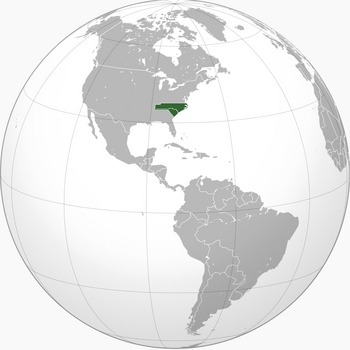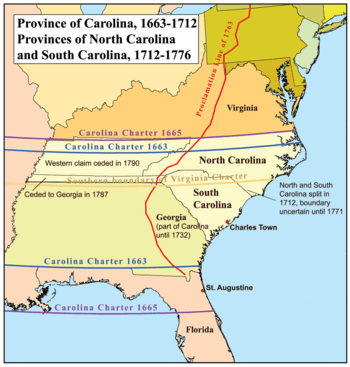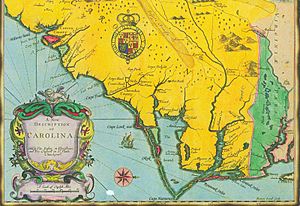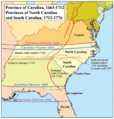Province of Carolina facts for kids
Quick facts for kids
Province of Carolina
|
|||||||||||
|---|---|---|---|---|---|---|---|---|---|---|---|
| 1629–1712 | |||||||||||
 |
|||||||||||
 |
|||||||||||
| Status | Colony of England (1629–1707) Colony of Great Britain (1707–12) |
||||||||||
| Capital | Charles Town, South Carolina | ||||||||||
| Common languages | English, Tutelo, Muscogee, Catawban languages, Tuscarora, Cherokee, Chickasaw, Yuchi, Shawnee | ||||||||||
| Religion | Church of England (Anglicanism) | ||||||||||
| Government | Constitutional monarchy | ||||||||||
| Legislature | Lords Proprietors | ||||||||||
| Historical era | Colonial Era | ||||||||||
|
• Heath charter
|
1629 | ||||||||||
|
• British government buy-out of Lords Proprietors
|
1712 | ||||||||||
| Currency | Pound sterling | ||||||||||
|
|||||||||||
| Today part of | United States | ||||||||||
The Province of Carolina was an early British colony in North America. It started in what is now North Carolina. Over time, it grew to include parts of many present-day U.S. states. These states are North Carolina, South Carolina, Georgia, Alabama, Tennessee, Mississippi, and even parts of Florida and Louisiana.
The first idea for Carolina came in 1629. King Charles I of England gave the land to Sir Robert Heath. He named it "Carolana," which means "Charles's Land" in Latin. But this plan did not work out.
Later, in 1663, King Charles II gave the land to eight English noblemen. They were called the Lords Proprietors. He gave them this land to thank them for helping him get his throne back. The king also wanted Carolina to stop Spanish Florida from growing northward. These Lords Proprietors, especially Anthony Ashley-Cooper, controlled the colony from 1663 to 1729.
In 1669, the colony was divided into two main parts: Albemarle in the north and Clarendon in the south. Because the settlements were far apart and there were disagreements, a separate governor was appointed for the northern part in 1691. By 1712, these two parts officially became separate colonies: North Carolina and South Carolina.
Even after the split, the same Lords Proprietors still owned both colonies. However, a rebellion in 1719 led to the British government taking over South Carolina. By 1729, the government bought out most of the Lords Proprietors. This made both North and South Carolina "royal colonies," meaning they were directly controlled by the British king.
Contents
History of Carolina
The First Idea: 1629 Charter
On October 30, 1629, King Charles I of England gave land to Sir Robert Heath. This land was south of 36 degrees and north of 31 degrees latitude. He named it "Carolana," honoring himself. Heath wanted to settle French Protestants called Huguenots there. But King Charles said only members of the Church of England could live there.
Heath then gave his land grant to George, Lord Berkeley. However, King Charles I was executed in 1649, and Heath fled to France. After the king's son, Charles II, became king in 1660, Heath's family tried to claim the land again. But Charles II said their claim was not valid.
The Lords Proprietors Take Over: 1663 Charter
On March 24, 1663, King Charles II gave a new charter for Carolina. He gave it to eight English noblemen. This was a reward for their loyalty and help in getting him back on the throne. These eight men were known as the Lords Proprietors.
The 1663 charter gave them a huge amount of land. It stretched from the southern border of Virginia Colony (at 36 degrees north) down to 31 degrees north. This included the coast of present-day Georgia.
In 1665, the charter was changed a little. The northern border moved up to 36 degrees 30 minutes north. This included settlers who had moved from Virginia to the Albemarle Sound area. The southern border moved down to 29 degrees north. This included the Spanish settlement at St. Augustine. The charter also gave them all the land from the Atlantic Ocean westward to the Pacific Ocean.
The main Lords Proprietors included Edward Hyde, George Monck, William Craven, John Berkeley, Anthony Ashley Cooper, Sir George Carteret, Sir William Berkeley, and Sir John Colleton. Lord Shaftesbury (Anthony Ashley Cooper) was the most active. He and his secretary, the philosopher John Locke, wrote the Fundamental Constitutions of Carolina. This was a plan for how the colony would be governed.
The Lords Proprietors had a lot of power, almost like the king. The colony's government had a governor, a powerful council (half chosen by the Proprietors), and a weaker assembly elected by the people.
Early Settlements
The first English attempt to settle in Carolina was the Lost Colony on Roanoke Island. However, it did not last. The first permanent English settlement began in 1653. Settlers from Virginia Colony, New England, and Bermuda moved to the Albemarle Sound area. This area became known as the Albemarle Settlements. By 1664, it was organized as Albemarle County.
In 1665, Sir John Yeamans started another English settlement on the Cape Fear River. He named it Clarendon. But this settlement was short-lived.
A stronger settlement was founded in 1670. The Lords Proprietors sent 150 colonists to a new location near present-day Charleston, South Carolina. Many of these colonists came from Barbados. This settlement, called "Charles Town," grew quickly. It had a good natural harbor and traded a lot with the West Indies. Charles Town became the main government center for the entire province.
Dividing Carolina
The northern and southern parts of the colony were far apart. Because of this, they mostly operated on their own. In 1691, Philip Ludwell was made governor of the whole province. From then until 1708, the northern and southern settlements were under one government. The governor lived in Charles Town and appointed a deputy-governor for the north. During this time, people started calling the two parts North Carolina and South Carolina.
Carolina was the first of the English colonies in North America to have a detailed plan. This plan was called the Grand Model. It included a constitution, the Fundamental Constitutions of Carolina, written by John Locke.
Problems and Royal Control
From 1708 to 1710, there were many disagreements in the colony. People could not agree on who should be elected to government. For over two years, there was no official government. This led to Cary's Rebellion. Also, wars like the Tuscarora War and the Yamasee War happened. The Lords Proprietors struggled to make strong decisions. All these problems led to North and South Carolina having separate governments.
Some people think this period marked the official split of the colonies. But the official split happened in 1729. That year, seven of the Lords Proprietors sold their shares in Carolina to the British Crown. This made both North Carolina and South Carolina "royal colonies." This meant the king directly controlled them. The eighth share belonged to John Carteret, 2nd Earl Granville. He kept a sixty-mile-wide strip of land in North Carolina. This area was known as the Granville District. It caused many disputes until the American Revolutionary War.
Governments under the Proprietors and under the Crown were similar. The main difference was who chose the officials: the Lords Proprietors or the King.
The Province of Georgia
In 1732, King George II created a new colony called the Province of Georgia. This land was taken from the southern part of South Carolina.
Images for kids
See also
 In Spanish: Provincia de Carolina para niños
In Spanish: Provincia de Carolina para niños





